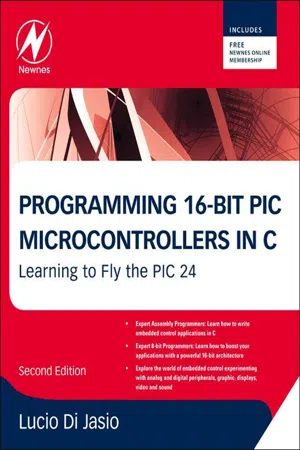
- 416 pages
- English
- ePUB (mobile friendly)
- Available on iOS & Android
About this book
New in the second edition: - MPLAB X support and MPLAB C for the PIC24F v3 and later libraries- I2C™ interface- 100% assembly free solutions- Improved video, PAL/NTSC- Improved audio, RIFF files decoding- PIC24F GA1, GA2, GB1 and GB2 support Most readers will associate Microchip's name with the ubiquitous 8-bit PIC microcontrollers but it is the new 16-bit PIC24F family that is truly stealing the scene. Orders of magnitude increases of performance, memory size and the rich peripheral set make programming these devices in C a must. This new guide by Microchip insider Lucio Di Jasio teaches readers everything they need to know about the architecture of these new chips: How to program them, how to test them, and how to debug them. Di Jasio's common-sense, practical, hands-on approach starts out with basic functions and guides the reader step-by-step through even the most sophisticated programming scenarios. Experienced PIC users, including embedded engineers, programmers, designers, and SW and HW engineers, and new comers alike will benefit from the text's many thorough examples, which demonstrate how to nimbly sidestep common obstacles and take full advantage of the many new features.!- A Microchip insider introduces you to 16-bit PIC programming the easy way!- Condenses typical introductory "fluff" focusing instead on examples and exercises that show how to solve common, real-world design problems quickly- Includes handy checklists to help readers perform the most common programming and debugging tasks
Frequently asked questions
- Essential is ideal for learners and professionals who enjoy exploring a wide range of subjects. Access the Essential Library with 800,000+ trusted titles and best-sellers across business, personal growth, and the humanities. Includes unlimited reading time and Standard Read Aloud voice.
- Complete: Perfect for advanced learners and researchers needing full, unrestricted access. Unlock 1.4M+ books across hundreds of subjects, including academic and specialized titles. The Complete Plan also includes advanced features like Premium Read Aloud and Research Assistant.
Please note we cannot support devices running on iOS 13 and Android 7 or earlier. Learn more about using the app.
Information
The First Flight
Publisher Summary
Flight Plan
Preflight Checklist
Table of contents
- Cover image
- Title page
- Table of Contents
- Copyright
- Dedication
- Preface
- Introduction to the Second Edition
- Introduction
- Part I: First Flights
- Part II: Flying “Solo”
- Part III: Cross-Country Flying
- Index